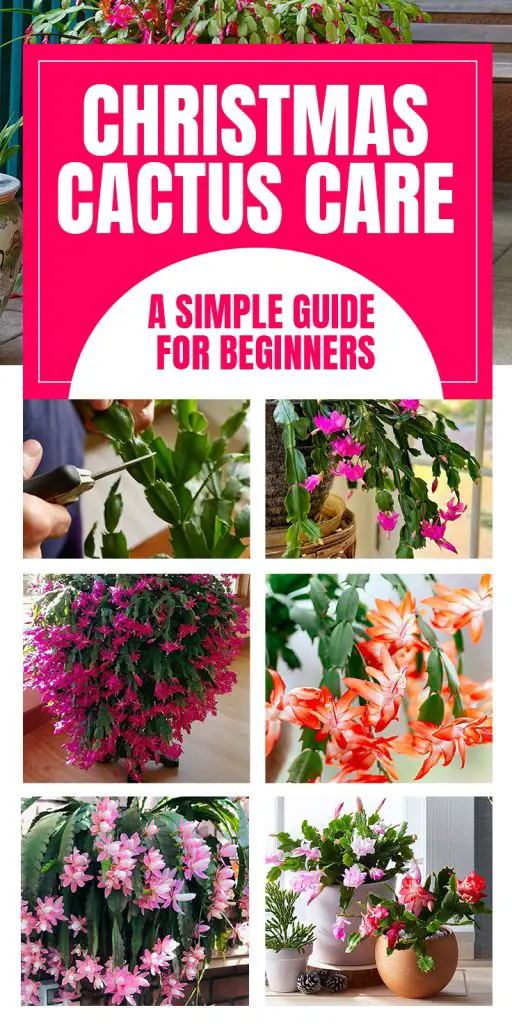I’ll never forget the day my grandmother handed me my first Christmas cactus cutting. That beautiful plant had been blooming faithfully every holiday season for over 20 years in her sunny kitchen window.
If you’re new to caring for these stunning holiday plants, don’t worry – I’ll share everything I’ve learned about keeping them happy and blooming.

Types of Holiday Cactus
Understanding Different Varieties
The first thing I discovered about Christmas cactus care was that most plants sold in stores aren’t actually Christmas cactus at all! Let me break down the differences I’ve learned.
The Thanksgiving cactus is what you’ll usually find in garden centers and grocery stores. You can spot it by its pointy cactus leaves and November-December blooming period. They’re more common because they’re easier to ship and handle.
True Christmas cactus plants have more rounded, scalloped leaves and bloom from December into January. They tend to be a bit leggier than their Thanksgiving cousins.
The Easter cactus is like the spring cousin of the family. While it looks similar, it belongs to a completely different plant group and saves its blooms for springtime.
Natural Growing Habits
Unlike regular desert cacti, these Christmas cactus plants are tropical! They’re native to the rainforests of Central and South America.
In nature, they grow attached to trees and rocks (they’re epiphytic). While they attach themselves to other plants, they’re not parasitic – they just need a place to perch!
Essential Care Tips
Light and Location
Proper cactus light is crucial for healthy growth. Your plant needs lots of bright, indirect light to produce those gorgeous Christmas cactus flowers.
Never place them in direct sun though – I learned this the hard way when my plant got sunburned! They can handle lower light, but they bloom much better with bright, filtered light.
Watering Guidelines
When it comes to cactus water, these plants are nothing like their desert cousins. I check my holiday cactus weekly for water needs.
Water thoroughly when the soil feels dry, making sure the water drains completely. Never let your plant sit in standing water – they hate wet feet!
In my experience, watering frequency varies based on several factors:
- Room temperature
- Pot size
- Season
- Climate (I water more in my dry climate)
Soil and Potting
For successful Christmas cactus care, use a well-draining cactus soil mix. Their roots need to breathe, so the right soil is essential.
Here’s something surprising I discovered – these plants actually perform better when they’re a bit pot-bound! I only repot mine every 2-3 years.
The best time for repotting is a couple months after blooming, typically in spring or early summer. This timing has worked perfectly for all my plants.
Temperature and Humidity
Your Christmas cactus plant enjoys the same comfortable temperatures we do, around 65-75 degrees. I always bring mine inside before any chance of frost.
These tropical beauties love humidity! I create extra moisture by using a pebble tray – just fill a saucer with pebbles and water, keeping the pot above the water level.
Maintenance Care
Fertilizing Schedule
Proper fertilizing is key for how to take care of Christmas cactus. I start feeding when new growth appears in spring.
Monthly fertilizing through mid-summer keeps my plants lush and healthy. Remember to stop fertilizing before the bloom cycle begins.
Getting Your Cactus to Bloom
Here’s my secret to getting those precious Christmas cactus flowers – start preparing 6-8 weeks before you want blooms.
These plants need long dark periods (12-14 hours) and cooler temperatures (50-55 degrees) to trigger blooming. I put mine in a spare room where it won’t get any artificial light at night.
Once you see those tiny buds forming, maintain stable conditions. Even small changes can cause bud drop – I lost all my buds once just by moving the plant!
Pruning and Propagation
Christmas cactus propagation is one of my favorite gardening activities! I prune yearly to maintain shape, and those cuttings become new plants.
The process is simple: cut between leaf segments, let the cuts heal for a few days, then plant them about half an inch deep in cactus soil. Keep the soil lightly moist, and you’ll see roots in about two weeks!
Common Problems
Stress Signs
Over-watering is the biggest enemy of Christmas cactus care. Watch for signs like root rot, limp foliage, or branches rotting at the base.
If your plant develops a reddish hue, it’s probably getting too much sun or not enough water. This is your plant’s way of crying for help!
Here’s what I do when problems arise:
- Let the soil dry completely between waterings
- Switch to a breathable terracotta pot
- If things look dire, I remove the plant, clean the roots, and repot in fresh cactus mix
Unlike desert plants in a cactus terrarium, these beauties need different care. While some people might switch to a poinsettia plant during the holidays, I find that a well-cared-for Christmas cactus can be even more rewarding.
These Christmas cactus care tips have helped me grow healthy plants that bloom reliably year after year. Remember, every plant is unique, and it might take some time to find the perfect care routine for your specific situation.
Don’t get discouraged if your first attempt isn’t perfect – I killed several plants before getting it right! Now my Christmas cactus plant is the star of my holiday decor, bringing beautiful blooms right when we need them most.
With patience and these care guidelines, you’ll be well on your way to becoming a Christmas cactus expert.


